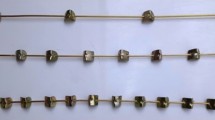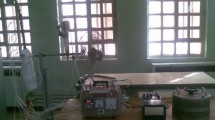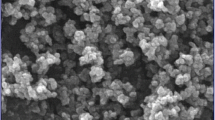Abstract
Heat pipes are one of the heat transfer devices adopted in various applications due to its high heat transfer capability. Recently, heat pipes are charged with different nanofluids to increases its performance. Thermal performance of heat pipe charged with nanofluids depends of various factors related to operating conditions, working fluids, heat pipe, etc. Thus, extensive experimentation work is required to recommend appropriate parameters for different industrial applications. In such cases, in order to reduce experiments and to propose the appropriate combination of parameters, experimentation results need to be modeled using fundamentals of simulation. In the Part I of the paper, extensive experiments have been carried out on cylindrical heat pipe with silver nanofluid as working medium. In the present paper, total of 96 artificial neural network models have been created and trained on the basis of the total 700 data sets presented in Part I of the paper. Out of 700 data sets, eight data sets have been randomly separated for post-training simulation of the model, while 692 data sets have been employed for formulating the ANN model using the ANN tool of MATLAB student version available at the college. The models have been prepared to predict the thermal performance of cylindrical heat pipe under study when one, two and three parameters have been considered as output neurons one by one and six parameters as input neurons. Out of six input parameters, heat load, average evaporator and average condenser temperature are related to operating condition, size and concentration of silver nanoparticles are related to working fluid, and inclination angle is related to position of heat pipe. Trained 96 ANN models have been simulated using eight data sets, and the best ANN model has been proposed on the basis of minimum value of error in prediction in terms of MSE, NMSE, MAE, MARD and MRE. The best ANN model identified for one, two and three output neurons is single-layer feed-forward backpropagation network with six neurons of hidden layer, cascade feed-forward backpropagation network having three neurons at hidden layer and single-layer feed-forward backpropagation network with 12 neurons of hidden layer, respectively. It is also concluded that for single output neuron, any one type of error in prediction can be considered to select the best ANN model. But for more number of output neurons, comparison of various types of error in prediction is essential to judge the best ANN model.




Similar content being viewed by others
Abbreviations
- h :
-
Overall heat transfer coefficient
- i :
-
ith number of data
- k :
-
Thermal conductivity
- n :
-
Total number of data
- Q :
-
Heat load on heat pipe
- R :
-
Thermal resistance
- S :
-
Size of nanoparticle
- T c :
-
Average condenser temperature
- T e :
-
Average evaporator temperature
- V A :
-
Actual value
- V P :
-
Predicted value
- Ø:
-
Concentration of nanoparticle
- θ :
-
Angle of inclination of heat pipe
- Σ:
-
Summation
- ANN:
-
Artificial neural network
- CFB:
-
Cascade forward backpropagation
- EBP:
-
Elman backpropagation
- FFDD:
-
Feed-forward distributed time delay
- FFN:
-
Feed-forward backpropagation network
- GR:
-
Generalized regression
- MAE:
-
Mean absolute error
- MARD:
-
Mean absolute relative deviation
- MLFFN:
-
Multilayer feed-forward network
- MRE:
-
Mean relative error
- MSE:
-
Mean squared error
- NMSE:
-
Normalized mean squared error
- RB:
-
Radial basis
References
S. Khandekar, X. Cui, M. Groll, Thermal performance modeling of pulsating heat pipes by artificial neural networks, in Proceedings of 12th International Heat Pipe Conference, Moscow, Russia, pp. 215–219 (2002)
X. Cui, J. Weng, M. Groll, Heat transfer performance model of pulsating heat pipe based on neural network. J. Chem. Ind. Eng. (China) 54(9), 1319–1322 (2003)
H. Shokouhmand, N. Gharib, H. Bahrami, Modeling of closed loop pulsating heat pipes by neural networks, in Proceedings of ESDA2006, 8th Biennial ASME Conference on Engineering Systems Design and Analysis, Torino, Italy, ESDA2006-95417 (2006)
A. Latha, K. Vijaya Kumar Reddy, J. Chandra Sekhara Rao, A.V. Sita Rama Raju, Performance analysis on modeling of loop heat pipes using artificial neural networks. Indian J. Sci. Technol. 3(4), 463–467 (2010)
H. Salehi, S. Zeinali Heris, M. Koolivand Salooki, S.H. Noei, Designing a neural network for closed thermosyphon with nanofluid using a genetic algorithm. Braz. J. Chem. Eng. 28(01), 157–168 (2011)
V.M. Patel, H.B. Mehta, Artificial neural network modeling of a closed loop pulsating heat pipe. Int. J. Mech. Aerosp. Ind. Mechatron. Manuf. Eng. 10(10), 1828–1831 (2016)
A. Jokar, A.A. Godarzi, M. Saber, M.B. Shafii, Simulation and optimization of a pulsating heat pipe using artificial neural network and genetic algorithm. Heat Mass Transf. 52(11), 2437–2445 (2016). https://doi.org/10.1007/s00231-016-1759-8
Author information
Authors and Affiliations
Corresponding author
Additional information
Publisher's Note
Springer Nature remains neutral with regard to jurisdictional claims in published maps and institutional affiliations.
Rights and permissions
About this article
Cite this article
Chavda, N.K. Investigation of Thermal Performance of Cylindrical Heat Pipe Using Silver Nanofluid: Part-II: Prediction Using Artificial Neural Network. J. Inst. Eng. India Ser. C 101, 115–124 (2020). https://doi.org/10.1007/s40032-019-00502-4
Received:
Accepted:
Published:
Issue Date:
DOI: https://doi.org/10.1007/s40032-019-00502-4




